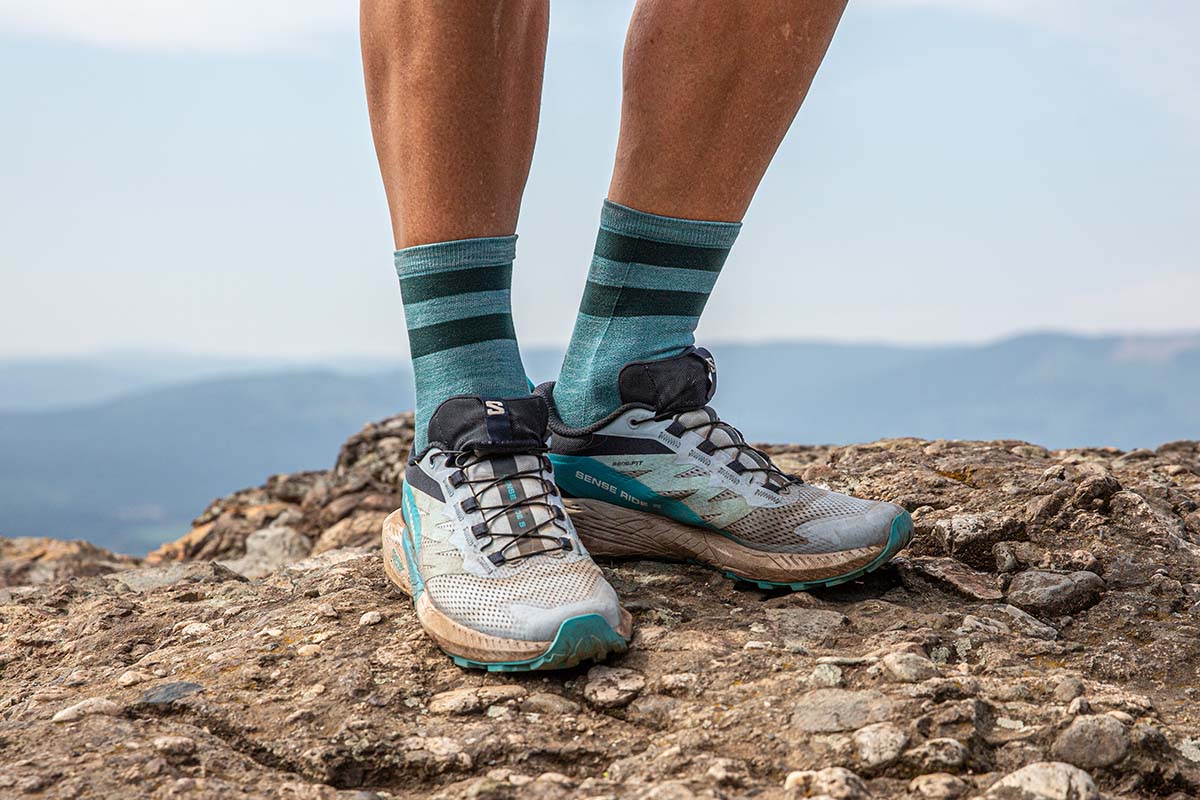
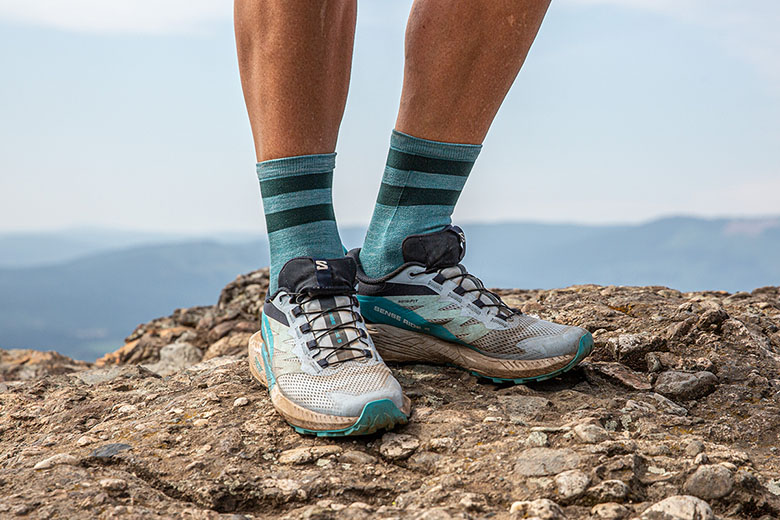
Price: $140
Weight: 1 lb. 2.3 oz (women’s 8.5)
Cushioning: Moderate
Drop: 8.3mm
What we like: A solid all-rounder that can handle everything from daily training to moderately technical mountain runs.
What we don’t: Doesn’t stand out in any one area; not our favorite lacing system.
See the Women's Sense Ride 5 See the Men's Sense Ride 5
Trail running shoes are a dime a dozen these days, but that doesn’t mean it’s easy finding a design that’s equally at home on quick door-to-trail runs as it is during ultra-distance pursuits. Enter Salomon’s Sense Ride 5, a do-it-all option that can handle most trails with aplomb. We recently put the women’s version through its paces in the Pacific Northwest, racking up over 100 miles on terrain ranging from steep, dusty trails to slick boulders and thick mud. While not a standout in any one area, we’re happy to report that the Sense Ride is a well-rounded performer that balances its priorities well. Below we break down our experiences with the Sense Ride 5. To see how it stacks up to the competition, check out our article on the best trail running shoes.
Traction is far and away my top priority when it comes to choosing a pair of trail runners, and the Salomon Sense Ride 5 proved to be adequate—but certainly not standout—in this department. Starting with the good news, the modest 3.5-millimeter lugs performed better than expected on terrain ranging from loose dust to slimy mud. In fact, they inspired enough confidence that I had no qualms about hurtling down steep trails—even those littered with gravel and pine needles—and it was a similarly positive experience running back up. I was also impressed by the shoes’ ability to brake quickly. More than once, my dog took off after a deer with me on the other end of his leash, and the Sense Ride allowed me to dig in my heels and prevent a full-on chase.
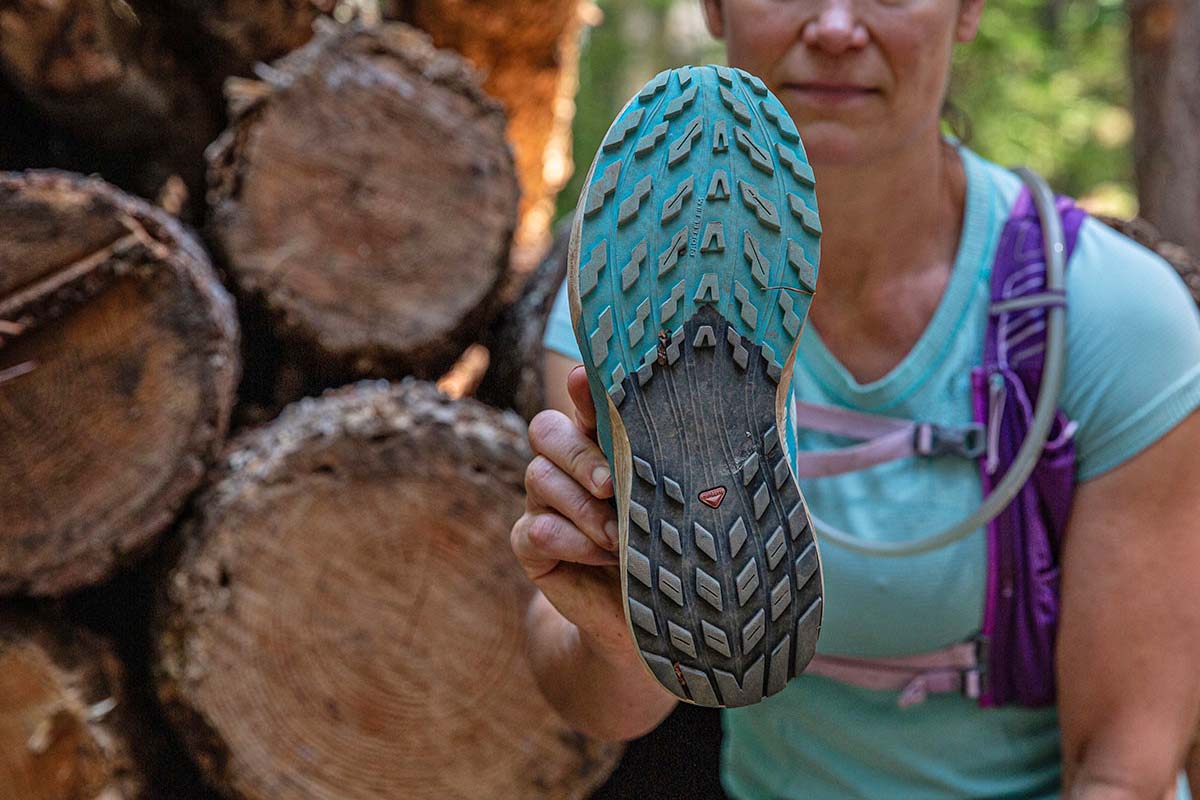
That said, the Sense Ride 5 does have some grip limitations. Most notably, I found the shoes difficult to trust on wet rock and slick asphalt—enough so that I slowed down each time I encountered either surface on my runs. I also noticed a lack of grip when traversing on off-camber trails, as the lugs don’t wrap around the sides (although the advantage is that I’ve found I’m less likely to nick my opposite leg when running). With all this in mind, I’m much more likely to reach for a more aggressive option—like La Sportiva’s Bushido III—on runs that involve a lot of varied and technical terrain. But for forest service roads, gravel paths, and well-maintained trails, the Sense Ride 5 is more than adequate.
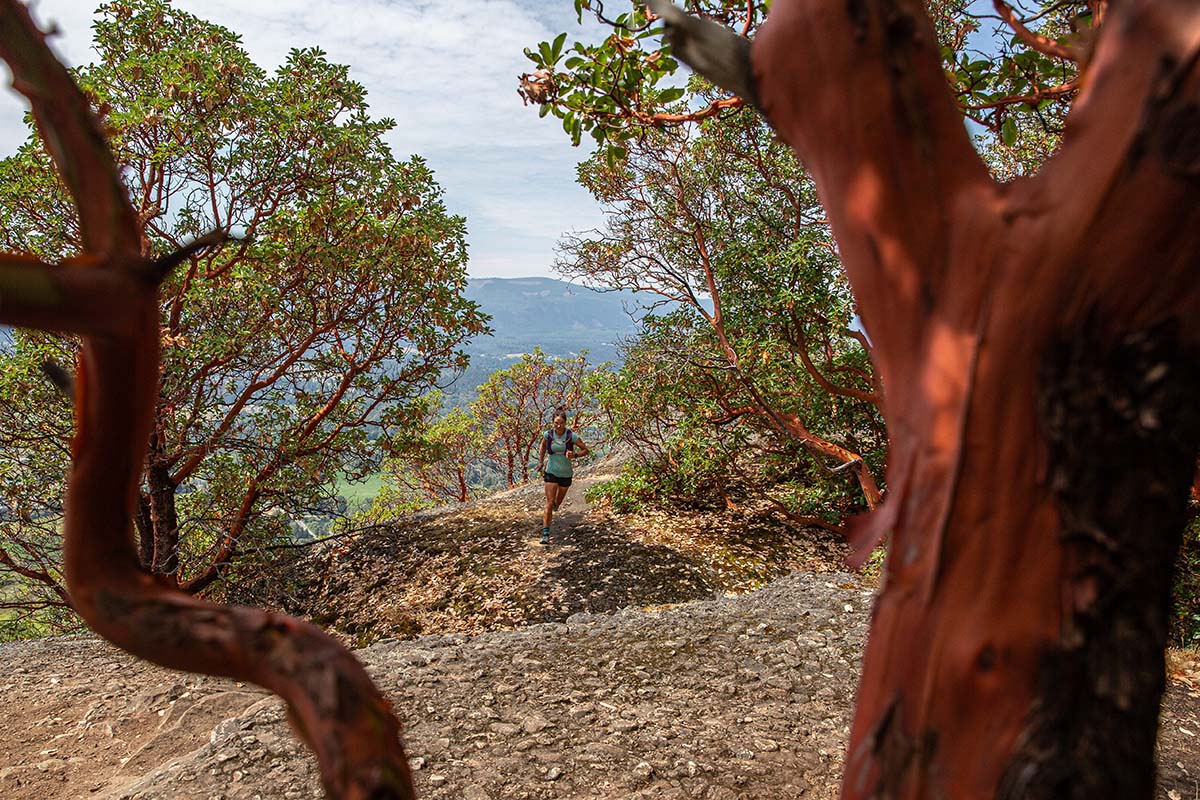
I came away with mixed feelings about the Sense Ride’s stability. On the plus side, the shoes’ relatively low stack height (21.3mm at the forefoot and 29.6mm at the heel) offers a very planted feel, and I’ve found it easy to confidently push off with each step. I’ve also suffered no rolled ankles—or even close calls—throughout testing, which is truly impressive. My only real complaint has to do with the Quicklace system, which doesn’t allow for very much fit customization compared to standard laces. Cinched tight, my heel and midfoot feel adequately locked in, but I haven’t been able to achieve the same fit at the forefoot (which is a little wider than I’d prefer) without creating excess pressure at the ankle. To be fair, the added room does contribute to the shoes’ great all-day comfort, but it comes at the cost of overall support.
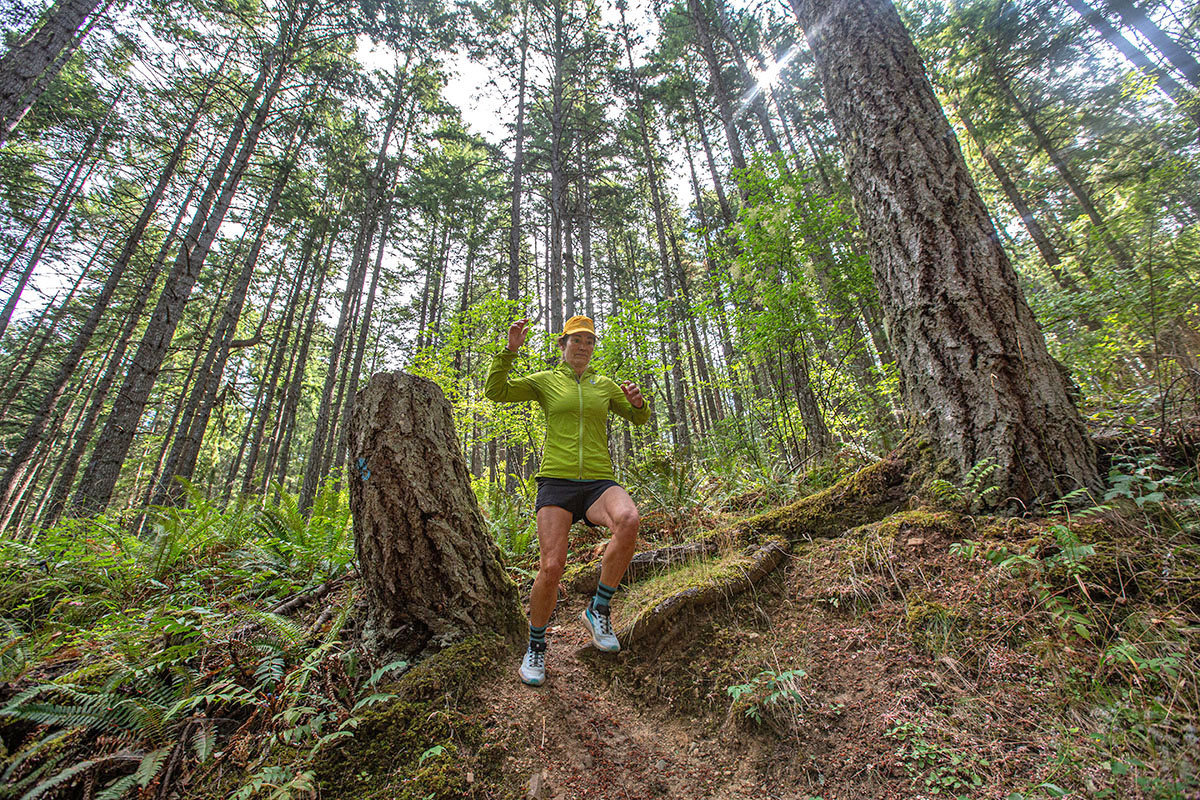
Similar to stability, the Sense Ride 5 is a bit of a mixed bag when it comes to cushioning. While the Energy Surge midsole has a relatively plush, road runner-like feel, I’m able to clearly feel rocks and roots underfoot. Combined with the relatively low stack height (21.3mm at the forefoot), the shoes don’t provide the best isolation from trail obstacles. It’s important to note that Salomon did boost padding at the heel (29.6mm), which is great for taking the sting out of landings, but overall, I’d categorize the Sense Ride as a little below average in terms of padding. If you prefer a cushier ride, it’s worth considering an alternative like Hoka’s Speedgoat 6 (33mm at the forefoot and 38mm at the heel) or Salomon’s own Ultra Glide 2 (26mm at the forefoot and 32mm at the heel), but expect sacrifices in overall stability and responsiveness.
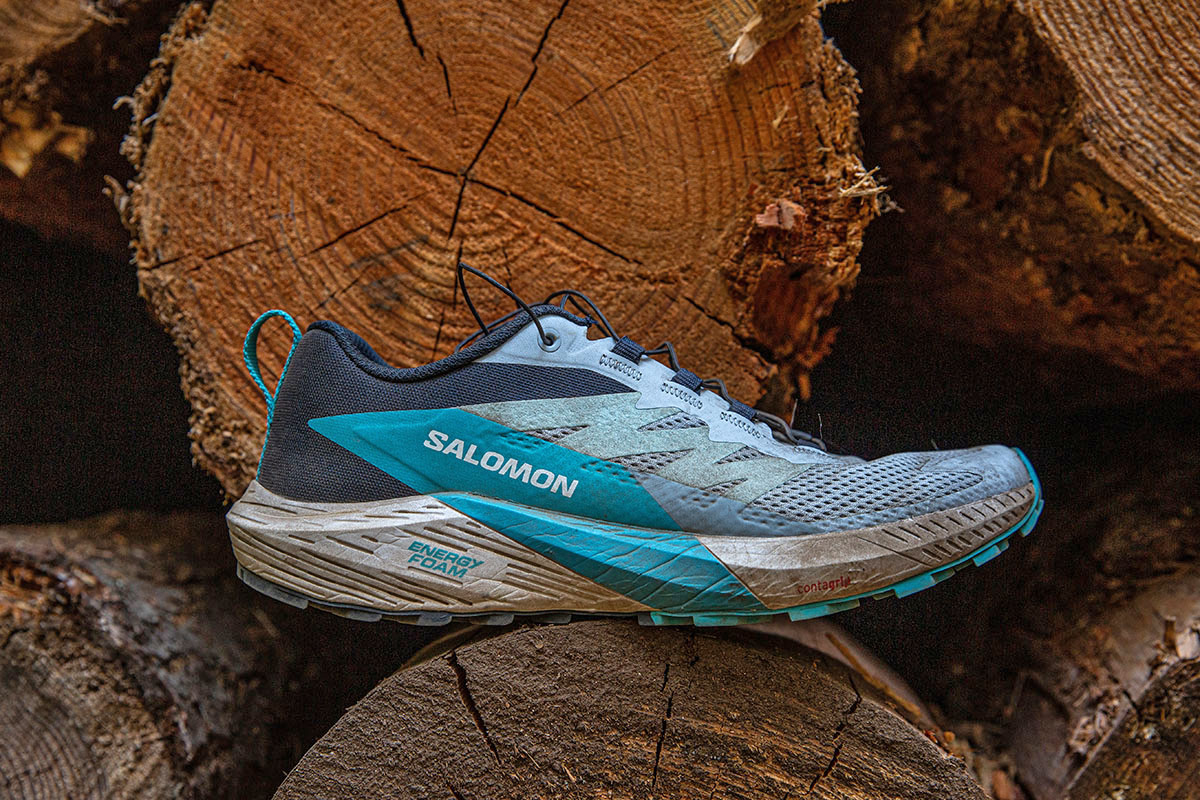
Trying them on for the first time, I was struck by the Salomon Sense Ride 5's excellent all-around comfort. For reference, I took the shoes right out of the box and onto a 10-mile run and experienced no hotspots or pressure points despite the lack of a break-in period. Additionally, the mesh upper has proven plenty breathable, even during a record-breaking heat wave, and the tongue and collar are both well-padded and notably plush. Weight and fit also come into play here: The shoes have a very sprightly feel underfoot, and the bit of extra room at the forefoot is great for accommodating swollen toes (but less so for stability, as mentioned above). Taken together, the Sense Ride feels a lot like a classic road running shoe and has become my go-to for recovery runs and long, slow rambles.
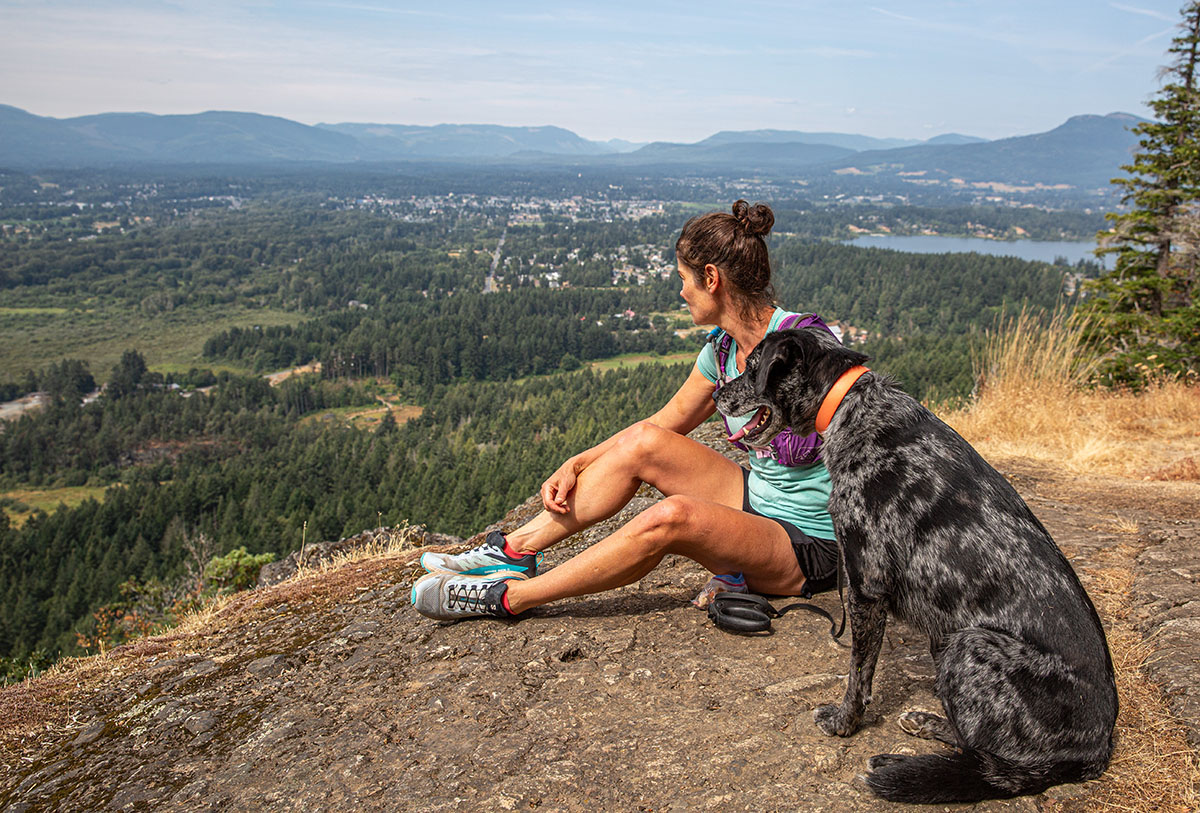
At 1 pound 2.3 ounces on my scale for a pair of women’s size 8.5 (listed weight is a little lower at 1 lb. 1.8 oz.), the Sense Ride 5 is right in line with most of the competition. For reference, Salomon’s similarly versatile Ultra Glide 2 weighs around the same at 1 pound 0.9 ounces, while Hoka’s Challenger 7 checks in a little lighter at 15.4 ounces per pair. In testing, the Sense Ride felt as nimble and sprightly as its weight would suggest, and I came away with no complaints regarding heft—in fact, I often forgot about the shoes entirely, which is all you can ask for in a trail runner.
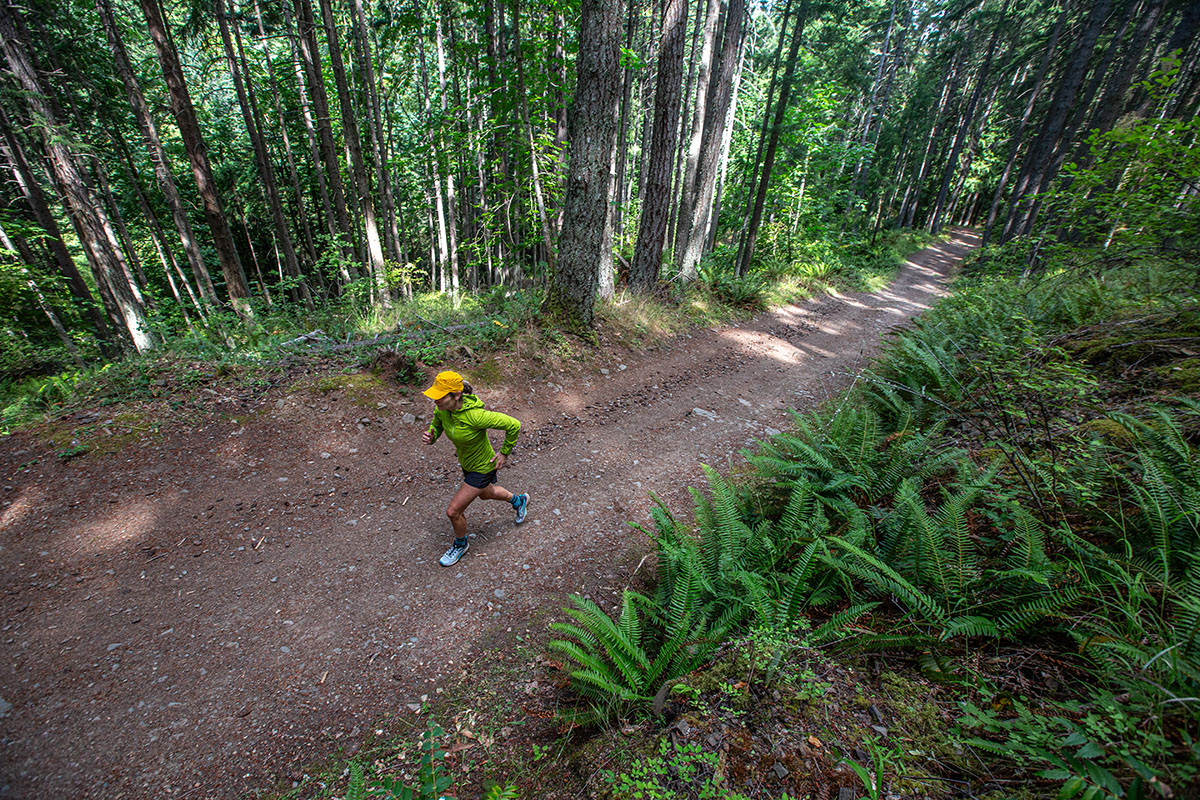
I’m admittedly hard on my trail running shoes, but the Sense Ride 5 has held up admirably to my abuse thus far. Apart from being very dirty, which is entirely cosmetic and to be expected, my pair is showing very few signs of wear: The overlays and stitching are in great shape, the lugs haven’t started to wear down, and the Quicklace system is holding up without issue. I do wish Salomon would have been more intentional with the pouch used to secure the excess lace material—it's obscured by the laces and very difficult to use—and have noticed a crease forming along the mesh upper where my foot flexes. But apart from these small gripes, all signs are positive that the Sense Ride will have a healthy lifespan.
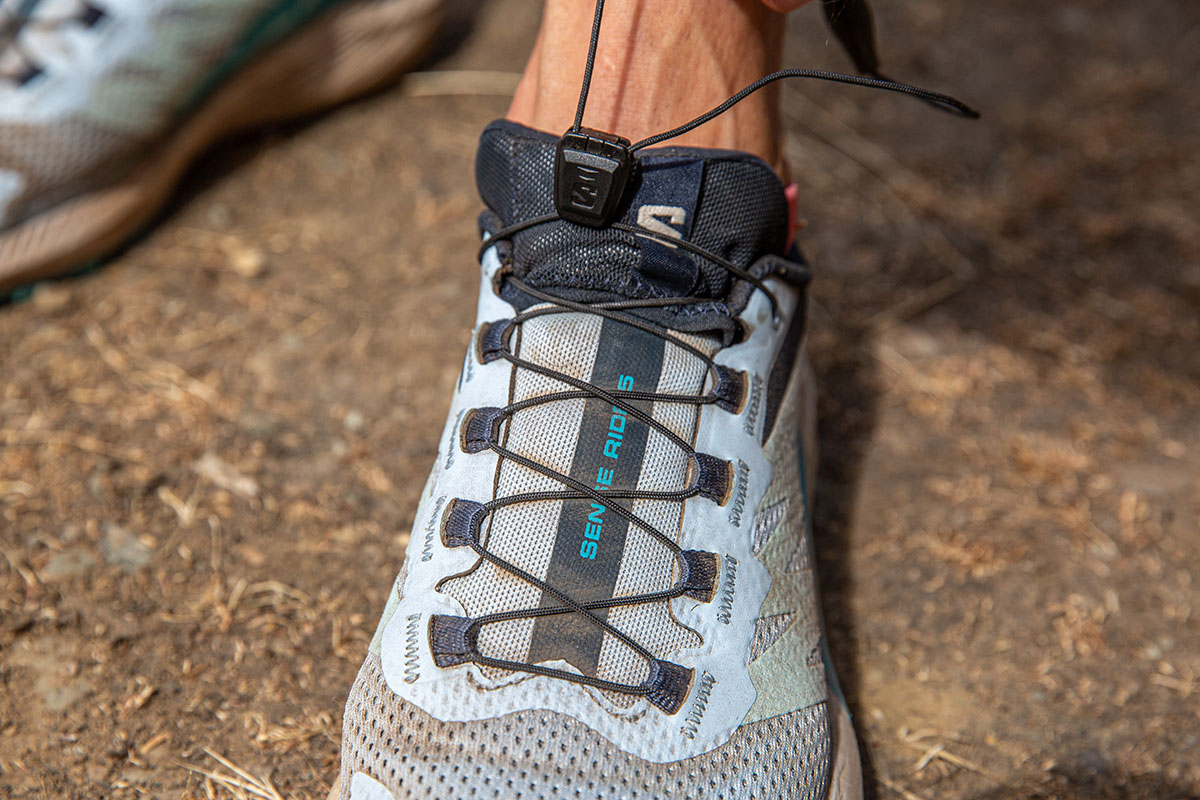
The Salomon Sense Ride 5 fit my foot very well out of the box in my usual women’s size 8.5. As I mentioned above, I did have some extra room in the forefoot, which wasn’t great for stability but could be a plus for those with wide feet. The Quicklace system also makes it difficult to customize tension, but overall, I’m happy with the fit and feel of this shoe. I’ve also come to like the low collar, which minimizes pressure around the Achilles and ankle and pairs well with no-show socks. Thankfully, I also haven’t had any issues with debris creeping in, which is a common complaint with low-top shoes in general.
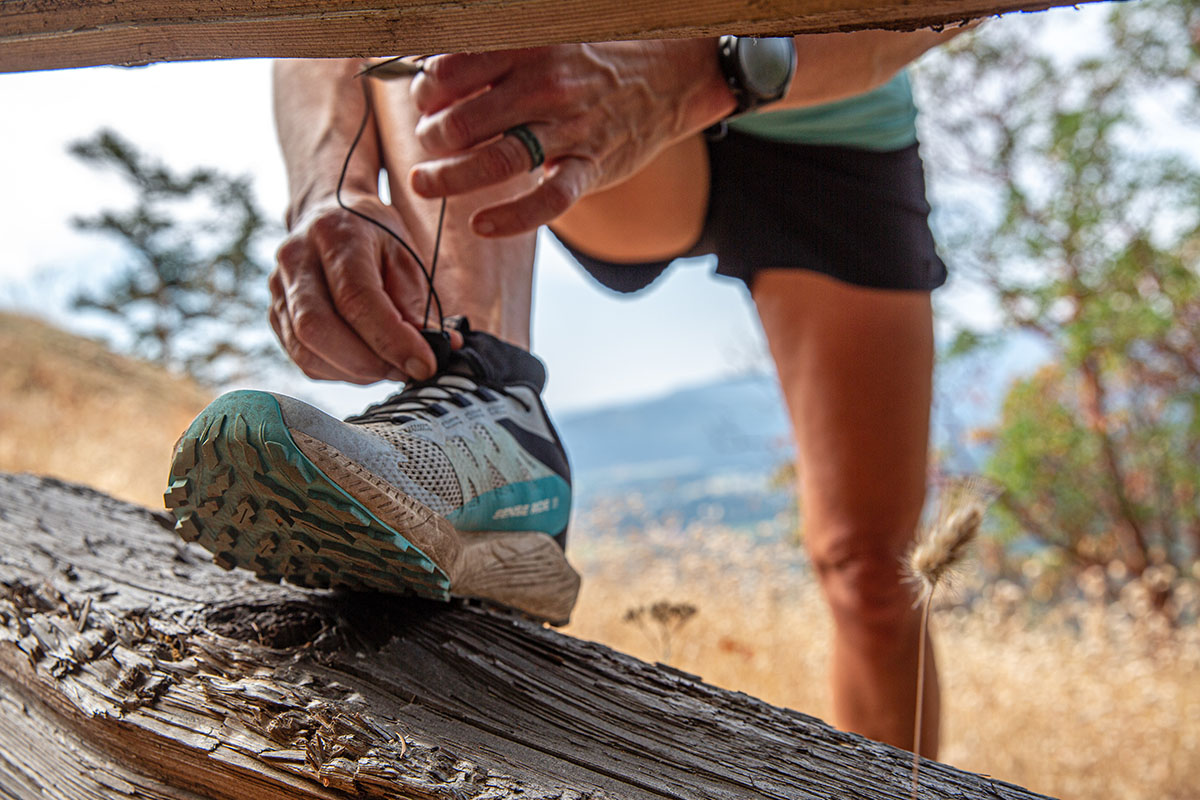
Our review above covers the women’s Sense Ride 5, and it’s also sold in a men’s version for the same price. In comparing the two, the men’s Sense Ride 5 is a little heavier at 1 pound 4.7 ounces per pair, features an 8-millimeter drop (the women’s version is 8.3mm), and comes in sizes from 7 to 14. Otherwise, the two shoes are largely identical apart from colorway options. Salomon also offers Gore-Tex-equipped versions for both men and women, which retail for $160 and check in a little heavier than their non-waterproof counterparts. They’re also a step down in breathability due to the waterproof membrane, which is something to consider if you frequently run in warm climates. Rounding out the collection is the Sense Ride 5 SR, which is a unisex design that meets ASTM standards for indoor slip resistance.
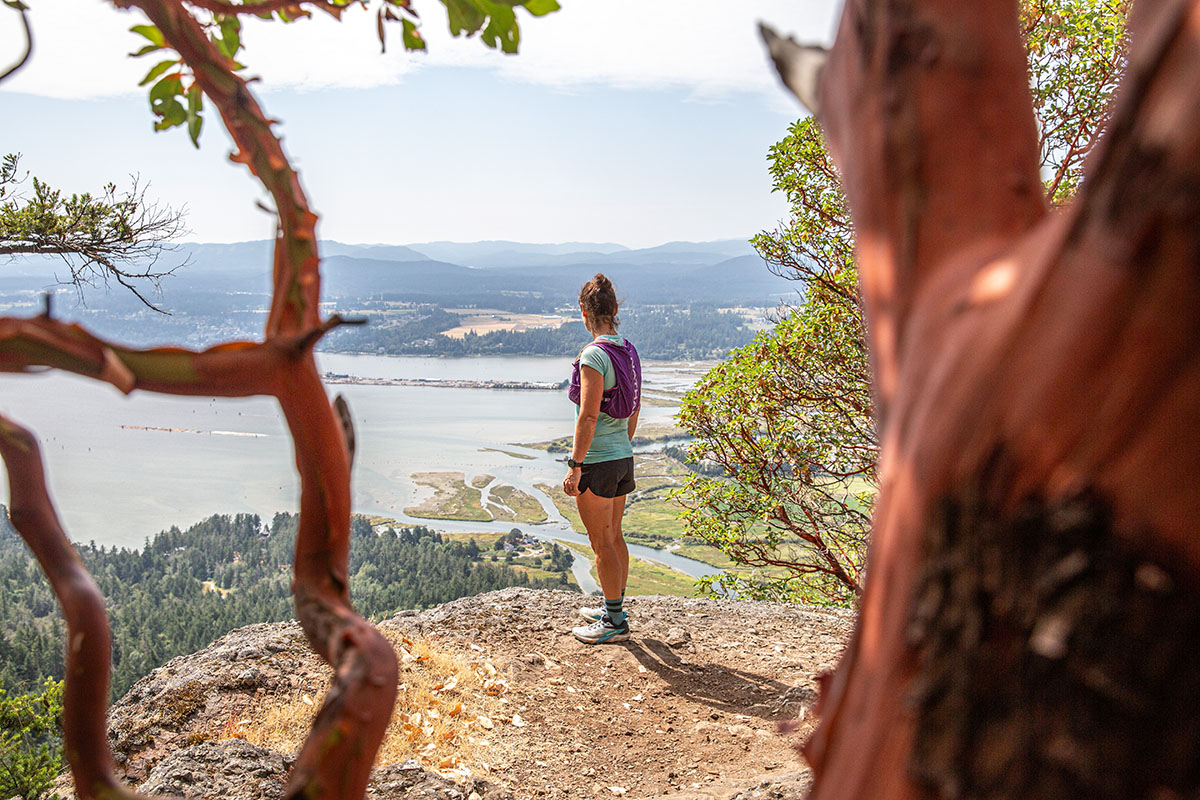
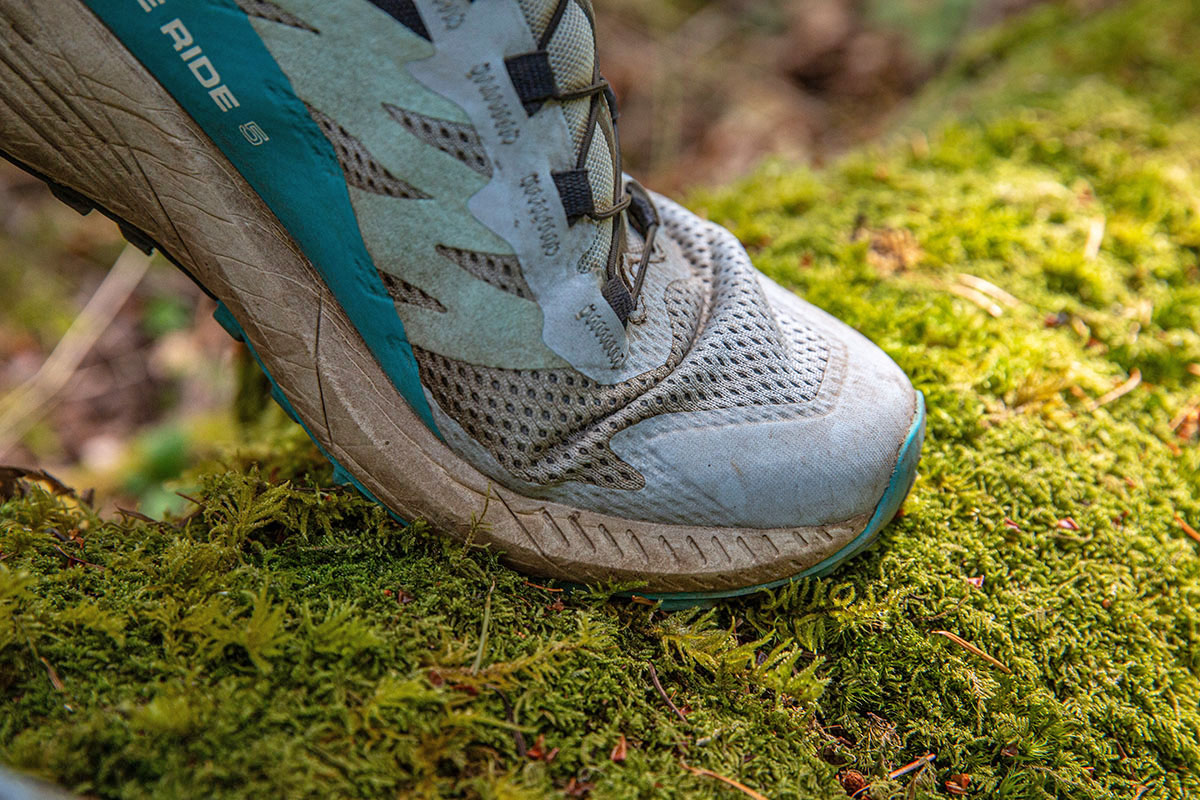
| Shoe | Price | Weight | Stack Height | Drop | Lugs |
|---|---|---|---|---|---|
| Salomon Sense Ride 5 | $140 | 1 lb. 1.8 oz. | 21.3mm forefoot / 29.6mm heel | 8.3mm | 3.5mm |
| Salomon Ultra Glide 2 | $150 | 1 lb. 0.9 oz. | 26mm forefoot / 32mm heel | 6mm | 3.5mm |
| Hoka Challenger 7 | $145 | 15.4 oz. | 24mm forefoot / 29mm heel | 5mm | 4mm |
| Nike Pegasus Trail 4 | $150 | 1 lb. 3.1 oz. | 25mm forefoot / 31mm heel | 6mm | Unavail. |
| Scarpa Golden Gate ATR | $159 | 1 lb. 1.3 oz. | 23mm forefoot / 27mm heel | 4mm | 4mm |
Salomon’s Sense Ride 5 puts it all together better than most, earning it our vote as the best overall trail running shoe this season. But as with most designs that aim to do it all, the Sense Ride does make some compromises in the name of versatility, one of which is cushioning. Enter Salomon’s own Ultra Glide 2, which boasts an additional 4.7 millimeters of padding under the forefoot and 2.5 under the heel for a notably plusher ride. Otherwise, the two shoes are largely similar, including 3.5-millimeter lugs that provide well-rounded traction, Salomon’s single-pull Quicklace system for fast on-trail adjustments, and competitively low weights that translate to great agility and responsiveness underfoot. In the end, a final decision will likely come down to how you prioritize cushioning versus connectedness to the trail.
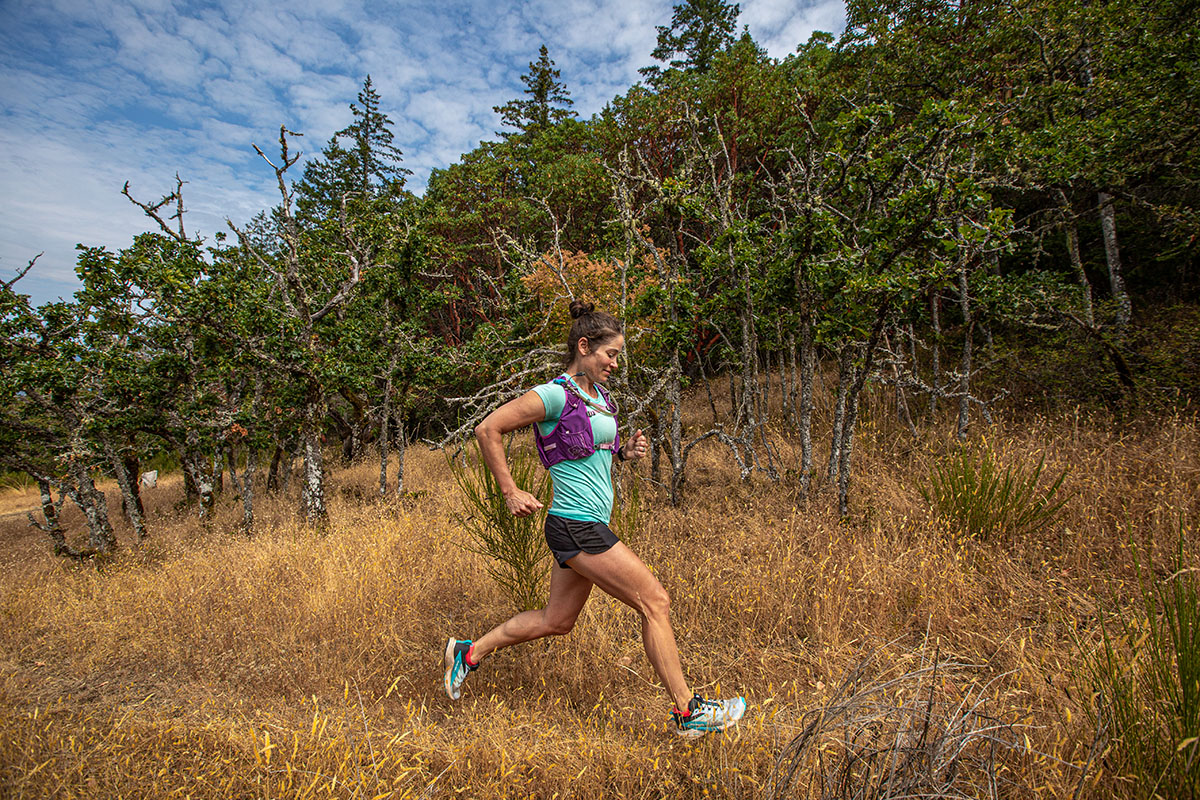
Next up is another do-it-all trail shoe: Hoka’s Challenger 7. For just $5 more than the Sense Ride, the Challenger offers a small boost in padding at the forefoot (24mm) and features a more aggressive outsole design that’s better suited for navigating slick or uneven terrain. We also prefer the Hoka’s traditional laces over the Salomon’s Quicklace system, as it’s much easier to customize fit. A final feather in the Challenger’s cap is its feathery 15.4-ounce weight. The Sense Ride offers a bit more in the way of stability, will hold up better over time, and strikes us as slightly more capable overall, but it’s a pretty close call between the two shoes.
Another all-rounder we love is Nike’s Pegasus Trail 4. The main event here is the large dose of Nike’s soft yet responsive React midsole, which offers great energy return as well as long-distance comfort (for reference, there’s 25mm of cushion under the forefoot and 31mm under the heel). You also get mostly rubber tread (unlike the Challenger above, which uses some foam) and reinforcements along the upper, resulting in a similar road-to-trail appeal as the Sense Ride. As far as downsides go, the shoe’s generous padding will feel unstable on rugged trails, and traction is middling overall. In the end, unless you’re after max-cushioned comfort, we’d go with the Sense Ride.

Last but not least is Scarpa’s Golden Gate ATR (short for “all terrain”), which again excels on runs that involve a mix of pavement, gravel, and trail. One of the first things you’ll notice is the shoe’s sock-like liner, which offers a snug fit and helps promote a very stable feel—unlike the Sense Ride, which has some extra room at the forefoot that’s hard to eliminate due to the Quicklace system. You also get a dual-density midsole that’s softer at the heel (ideal for impact absorption) and firmer at the front for great spring and propulsion, along with deeper lugs that are in their element on mud, dirt, rock, and snow. The net result is better technical performance than the Sense Ride (with a $20 price jump to match) but less appeal for mellow terrain and stretches of road running.